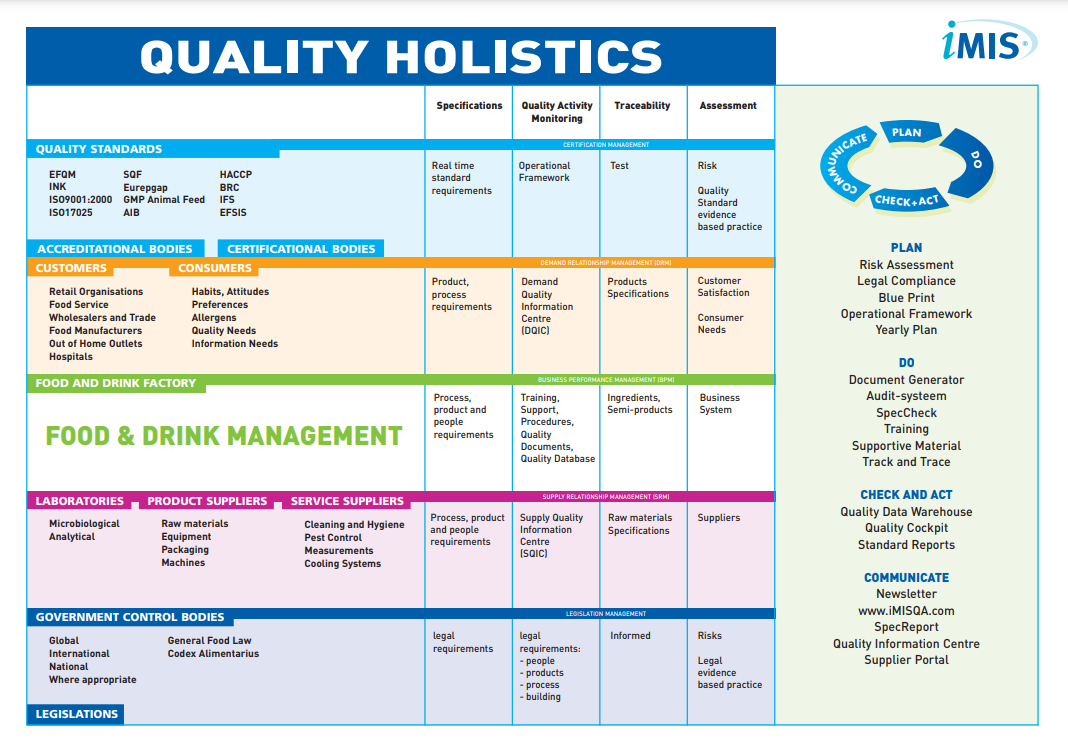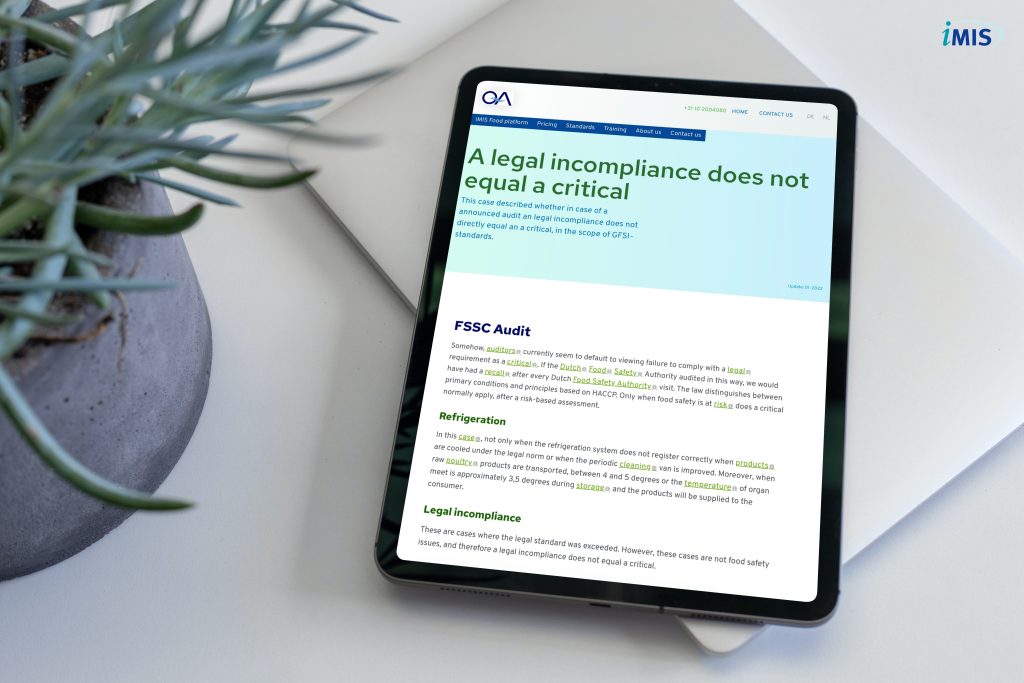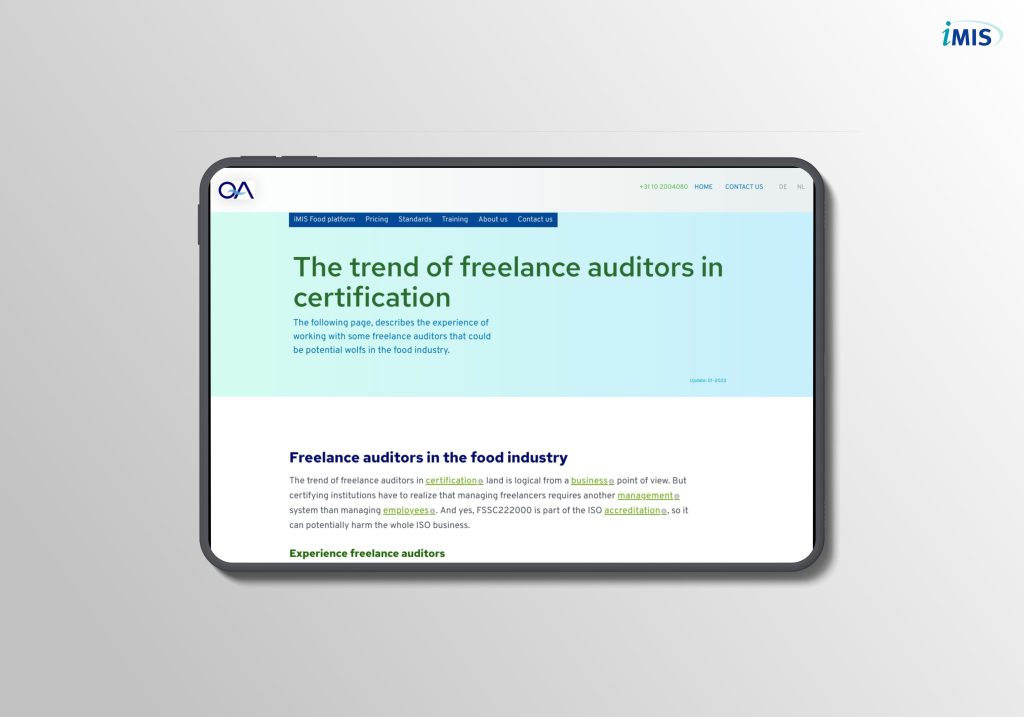Scope: Food Safety and Systems Thinking methodology
Product quality and food safety are high on the agenda and the food industry is increasingly confronted with rising quality costs. Every year, a company is confronted with more than 400 legislative changes in the field of HACCP, company equipment, labelling, additives and allergen management.
Standards vs Systems thinking
Standards such as FSSC 22000, BRC and IFS impose more than 2000 requirements on a food producer and customers demand substantive information about the products supplied. As a result, a food company pays a high bill for a quality department, the necessary software and the advisors to be called in for additional expertise. These quality departments are often staffed with people with a food (technological), microbiological background, food safety is of course about food. But if we look closely at the theme, it is about managing food safety, with an emphasis on managing all actors that can have an impact on food safety.
Systems thinking
The technical business administration course is specialized in the management of (food) technological themes in business. The training at the TUE in Eindhoven started in 1969 with a lecture on systems thinking, the basis for technological management.
Systems thinking is a scientific approach that tries to maintain an overview of the whole, instead of concentrating on individual parts without considering the role these parts play in the larger whole. The behaviour of a system (for example an ecosystem) is not regarded as a simple chain of cause-effect relationships, but as the interplay of interacting sub-systems, in which feedback plays an important role. Systems thinking requires a holistic view of the system to be studied. This means that not only the individual subsystems are considered, but especially also the way in which they interact and their place in the whole.
Actors for Food Safety Compliance
When we look at food safety management from a helicopter view, there are 5 main actors:
- The food company: business performance management
- The customers and consumers of the company: demand relationship management
- The company’s suppliers: supply relationship management
- Food legislation that must be complied with (license to produce): legislation management
- The Food quality standards to which the company has committed itself (license to sell): certification management
Within the food company, there are different departments and roles regarding food safety. Management determines the objectives of the company and allocates the investments. It is important that management invests in the right food safety structure and systems, enabling the company to perform well: business performance management (BPM). By giving the quality department the right tasks, responsibilities and resources, we can work structurally on a good one food safety culture within the company. It is also important that improvement circles are institutionalized at various levels. Senior management checks at least annually whether the objectives and investments lead to the desired result and operational management works with a central action list in which identified issues are solved curatively (the correction) and preventively (the corrective measure). The HACCP team has an important validating and verifying role within the company. By allowing the different departments to participate to this team, management ensures the correct signaling mechanisms in the company and everyone also feels responsible for any measures to improve food safety within the company.
The food company’s customers depend on the company’s food safety performance. The company serves its activities to be properly attuned to the requirements and wishes of customers and consumers with regard to the products and services supplied: demand relationship management (DRM). The customers use these products and services for the production, sale of food and eventually this food is bought by a consumer, possibly prepared and consumed. It is important that the ingredients, nutritional values and allergens of the food are known in the food chain and any necessary safeguarding steps required by HACCP so that any specific food safety hazard that may still be present in the product is reduced to an acceptable level.
The food company’s suppliers have the greatest impact on the company’s food safety performance. Most recalls are also caused by the suppliers of Food companies.
As a food company, you have the best grip on your own performance because you can manage and monitor it yourself. The supplier, on the other hand, delivers his performance on the basis of a good supplier selection and assessment, whereby it must be continuously validated and verified whether all HACCP hazards have been safeguarded. The supplier serves its activities to be properly attuned to the requirements and wishes of the Food company with regard to the products and services supplied: supply relationship management (SRM). The food company uses these products and services to produce, sell and eventually the food is consumed. It is important that it is known in the food chain that the ingredients, nutritional values and allergens of the food are known and any safeguarding steps required by HACCP so that any specific food safety hazard that may still be present in the product is reduced to an acceptable level.
As a food company you have to take into account all aspects of food law. For example, the legislation in the EU has been structured in such a way that you as a food company are personally responsible for food safety. Legislation has a major impact on the framework in which a food company can operate. It is therefore important to keep it. To make management of these legislative issues part of the business operations: legislation management. The company serves its activities to be properly attuned to the requirements and wishes of the legislation regarding the purchase, production, storage, transport and delivery of products and services. From the legislation, the preconditions for food companies are laid down in pre-requisite programs, and HACCP and mandatory microbiological validation and verification are part of the rules. Requirements are also set for the recall procedure, food labelling and traceability. In the Netherlands, EDP audits are even carried out in collaboration with the tax authorities, whereby the entire financial administration is related to the tracing and monitoring of the flow of goods. This exercise has already resulted in the closure of Food companies.
As a food company, you have to take into account the food quality standards. Both business to business customers and retailers often require a supplier to be certified for a standard recognized by the Global Food Safety Initiative: BRC Food, IFS Food, FSSC22000 or SQF.
It is therefore important to make management of this certification part of the business operations: certification management. The company serves its activities to be properly attuned to the requirements and wishes of these standards regarding the purchase, production, storage, transport and delivery of products and services. From the standards the preconditions for food companies are laid down in pre-requisite programs and, in addition to HACCP, TACCP and VACCP, form part of the rules. Requirements are also set for the recall procedure, food labelling, allergen management and traceability. In the Netherlands, there is a collaboration between the Food Safety Authority and the GFSI recognized standards, where the Food Safety Authority immediately reports this problem to the scheme manager when it detects a Food Safety problem. This so-called chain assurance has already resulted in the suspension of various food companies.
What is involved in managing food safety?
Managing food safety within food companies can be divided into 4 main themes:
1. Specifications: requesting, drawing up, issuing and securing specifications regarding raw materials, semi-finished products, processes and end products, with which legislation, quality standards and customer requirements are met.
2. Quality activities: drawing up, complying with and guaranteeing product and process parameters through procedures, job descriptions and responsibilities with which legislation, quality standards and customer requirements are met.
3. Traceability: registering all information flows and related actions regarding raw materials, semi-finished products, processes and end products, with which legislation, quality standards and customer requirements are met (transparency and consumer intimacy).
4. Assessment: testing whether the product and process parameters and the related procedures, job descriptions and responsibilities meet legislation, the quality standards and customer requirements that are set.

So you can ask yourself the following questions:
- Does my company issue the correct product specifications to the customer and do they contain the minimum legally correct microbiological criteria?
- Is the quality manual currently up to date with all the latest process descriptions, tasks and responsibilities and are these well known within the organization?
- Are all raw materials and end products properly registered and is it known which raw material reached the customer through which processing and end product? Is the status of the tracking system within the company properly monitored?
- Is there a complete overview of relevant legislation with which the company must comply and are any fines imposed by the Food Safety Authority known to the management and the certification body?
Combining the 5 main actors regarding Food Safety management with the 4 main themes gives the following definition:
Food Safety Compliance management:
Management of business performance, demand and supply relations, legislation and certification with regard to Food Safety, taking into specifications, quality activities, traceability and assessment.
The following Food Safety Compliance Matrix can be set up:
Food Safety Compliance Matrix:
| Management of | Specifications | Quality Activities | Traceability | Assessment | |
| Quality Standards | Certification | ||||
| Customers & Consumers | Demand Relationships | ||||
| Food Company | Business Performance | ||||
| Suppliers | Supply Relationships | ||||
| Legislation | Legislation |
Using this matrix we can specify the food safety themes for each actor.
| Management of | Specifications | Quality Activities | Traceability | Assessment | |
| Quality Standards | Certification | Standard requirements | Operational framework | Test, certification body informed | HACCP, TACCP, VACCP, standard based practice |
| Customers & Consumers | Demand Relationships | Product, process requirements | Demand Information Center | Products, specifications | Customer satisfaction, consumer needs |
| Food Company | Business Performance | Product, process and people requirements | Training, support, procedures, quality documents and database | Ingredients, semi-products, final products | Business System |
| Suppliers | Supply Relationships | Product, process and people requirements | Supply Information Center | Raw materials, services, specifications | Supplier selection and performance |
| Legislation | Legislation | Legal requirements | HACCP and prerequisite program | Food Safety Authority informed | HACCP, legal based practice |
We have worked out the Food Safety Compliance requirements for the Food Company:
Specifications
1.1 Process requirements | HACCP validated processes, routing well described
1.2 Product requirements | Drawing up the correct templates and, among other things, microbiological parameters that are issued
1.3 People requirements | Recording the required knowledge and skills required for Food Safety
Quality activity monitoring
2.1 Training | Ensuring that the entire company knows what needs to be done in terms of Food Safety (HACCP), fraud, defense, allergens, etc.
2.2 QA support | Where necessary, make a contribution to the line organization with Food Safety knowledge
2.3 Procedures | Facilitate up-to-date manual that must be complied with
2.4 Quality Documents | Facilitate up-to-date documentation in-house that demonstrably meets the requirements, such as calibration certificates, own registrations, specifications.
2.5 Quality Database | Status of the QA improvement circle: PLAN-DO-CHECK-ACT (PDCA), follow-up of open actions
Traceability
3.1 Ingredients | Knowing which raw materials are used and whether the recipes are up to date
3.2 Semi-products | Knowing which product status is present in each department, also in terms of allergen profile
3.3 Final products | Knowing which product status is present in each department, also in terms of allergen profile
Assessment
4.1 Business system | Checking whether the entire company works according to the established QA system.
| Management of | Specifications | Quality Activities | Traceability | Assessment | |
| Quality Standards | Certification | ||||
| Customers & Consumers | Demand Relationships | ||||
| Food Company | Business Performance | 1.1, 1.2, 1.3 | 2.1, 2.2, 2.3, 2.4, 2.5 | 3.1, 3.2 | 4.1 |
| Suppliers | Supply Relationships | ||||
| Legislation | Legislation |
In summary, Food Safety Compliance management consists of:
- the food company: business performance management
- the customers and consumers of the company: demand relationship management
- the company’s suppliers: supply relationship management
- Food legislation that must be complied with (license to produce): legislation management
- the Food quality standards to which the company has committed itself (license to sell): certification management
In the business world hardly any action is taken on this vision. The quality performance of a food company is related to the achievement of an FSSC222000, BRC Food or IFS Food certificate, this is only 5% of the Food Safety Compliance management. Food Safety Compliance management also requires other capacities than creating a cross-reference table for a GFSI recognized standard. The company must be equipped to continuously identify new legislation and standard requirements, as well as to pro-actively anticipate changing consumer needs and any issues in the Global Food Supply Chain. The appointment of a Food Safety Compliance Officer can be a first step in transforming the company into a real Sense and Response company with regard to Food Safety Compliance.
Related articles to Food Safety Compliance and Systems Thinking methodology
Many customers and visitors to this page 'Food Safety Compliance and Systems Thinking methodology' also viewed the articles and manuals listed below:



